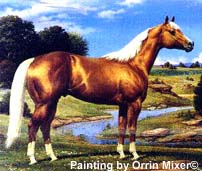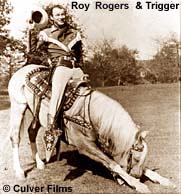

Palomino


Introduction: If you have any comments or suggestions, please click here.
Names: Palomino. The name seems to have been in general use only about 60 years and probably derives from the name of some early owner who took a special interest in these horses. It is also possible, as some have suggested, that the name is derived from the Spanish word palomilla, which means, among other things, "a cream-colored horse with white mane and tail."
Origin: Popular
in the United States. Descended from Arab
horses. The precise history of the
Palomino in America is still being searched out. Chief Quanah Parker of
the Comanches appears with one in an interesting photograph of the 1870's.
Today no Western parade is complete without its phalanx of Palominos in full
Western trappings. Though registrations have declined seriously from the
high reached in 1947, the splendid Palomino will always have a place in the
Western scene.
USA: Texas, California and Oregon. Numerous private
breeders. Also spread to Europe, the most important being the Duchess of
Rutland's stud at Pittern Hill House, Warwick, England. (British
Palomino Pony and Horse Society.)
The origin of the Palomino is unknown, but is most probably
Spanish. Presumably the horses went to America with the Spanish conquistadores,
and were there bred with admixtures of Arab
blood. Up till now, selection has been
made only according to purity of colour, but today efforts are being made to
exclude horses with pronounced shortcomings in conformation.
For many years Palominos were regarded simply as a color type
rather than a breed. Today, however, horses of Palomino coloration, which
also meet certain other breed requirements, may be registered in either of two
American associations for the purpose. Palomino horses have been known at
least since the days of the Spanish conquistadores. Today the stipulation
for color is "golden, with mane and tail of white, silver, or ivory."
Although Palomino coloration may occur in horses or ponies of any size, the
usual height of the animals used for riding and parade purposes is 58-64 inches,
and the weight from 1000 to 1200 pounds. This combination of height and
weight represents the body build of a sturdy saddle horse.
Breeding: It is still an unsettled
question whether the Palomino can be called a true breed, since horses of its
characteristic coloration often occur by accident in other families of
horses. Also, breeding to get a Palomino foal is not a simple
matter. The most reliable practice is to mate a Palomino to a
light-chestnut animal of strong Eastern blood, rather than to another
Palomino. Some horsemen are content to call the Palomino a breed,
maintaining that the genes have come down over the centuries from a pure strain
of golden horse, such as the ones seen in the Bayeux Tapestry, which records the
invasion of England in 1066 by the Normans.
Today
the Palomino may be a Morgan
or Tennessee
Walking Horse, a Quarter
Horse or Arabian
or other breed, but as long as he
is Palomino in coloring and a fine example of his type, he is likely to be one
of the most beautiful horses in the world.
Description: The
Palomino Horse Registry accepts horses that meet its standards of
coloration. It also groups Palominos into divisions according to the breed
that is strongest in the background of an individual animal. These
divisions include Thoroughbred, Arabian,
Saddle
Horse, Tennessee
Walking Horse, Morgan,
and Quarter
Horse. The Quarter
Horse bloodlines have produced
the highest proportion of Palominos and many of the best performers, including
the famous champion cutting horse, Cutter Bill.
One source gave this description of the conformation:
The ideal for riding purposes has a refined, clean head with large, dark eyes
and small, pointed ears. Straight nose-line. Long, beautifully
carried neck. Small withers. Rounded, oblique quarters with tail set
on low. Well-placed shoulders. Considerable depth in the
girth. Action: Good, grounded-covering walking step; trots with quite good
knee action; galloping ability.
Color: I have
found some of the most varied descriptions of any color in my sources for
Palominos. I may simply put all the statements that seem realistic for
now, and then decide which ones are the most accurate.
Coat
must be the color of a newly minted gold coin--not more than three shades
darker, nor more than three shades lighter. Hairs of mane and tail must be
at least 85 percent white. Face and legs may have white markings, but the
rest of the body must be a golden color.
Color
varies from cream or light blond to chestnut with a white mane and tail.
Often has white face markings. Another source says that it
comes in varying shades of iridescent gold with flaxen or silvery manes and
tails.
Outstanding feature is its colour, "Isabella," pure
gold with a metallic sheen like a freshly minted coin. Mane and tail are
snow white--up to 15% dark hairs in the mane and tail permissible.
Size: 14-16 hands. Any height--but usually from 11.2 to 14.2 hands for children's ponies.
Temperament: Intelligent, with "cow sense." Friendly.
Features: Belongs to the "Western Horse" group. It is not a breed but a colour. The ideal is a small, compact saddle horse. Has stamina, is tough and extremely resistant. A Palomino may be any type of breed--from pony to carthorse.
Uses: Most are bred for shows. Some jump and hunt. It is a stylish and popular Western horse. Recently a special favourite for children and as a show pony.
Accomplishments:
Curiosities: The majority of the much prized Greek chariot horses were described as Xanthos--coloring often translated as chestnut or dun, but while many Western ranchers insist that Buckskin (dun) horses are the hardiest, with the most "cow-sense," they do not "shine like the sun," as Xanthos horses were said to do. They probably looked far more like the modern golden horses of the West, the Palominos. Favored by the Kings of Yemen and beloved of Isabella of Spain; in Spain, the palomino color is sometimes called "Ysabella" in her honor.
Profiles:
Conclusion: